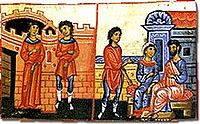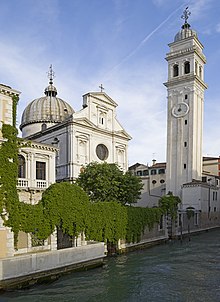Byzantine Greeks
Until the thirteenth century, education within the Byzantine Greek population was more advanced than in the West, particularly at primary school level, resulting in comparatively high literacy rates.
This position of strength had built up over time, for at the beginning of the Byzantine Empire, under Emperor Constantine the Great (r. 306–337), only a small part, about 10%, of the population was Christian.
[19] Among Slavic populations of southeast Europe, such as Bulgarians and Serbs the name "Rhomaioi" (Romans) in their languages was most commonly translated as "Greki" (Greeks).
[26] The number of the poor fluctuated in the many centuries of Byzantium's existence, but they provided a constant supply of muscle power for the building projects and rural work.
Their numbers apparently increased in the late fourth and early fifth centuries as barbarian raids and a desire to avoid taxation pushed rural populations into cities.
[32] In the Taktika of Emperor Leo VI the Wise (r. 886–912), the two professions defined as the backbone of the state are the peasantry (geōrgikē, γεωργική, "farmers") and the soldiers (stratiōtikē, στρατιωτική).
[33] There are records for the small town of Lampsakos, situated on the eastern shore of the Hellespont, which out of 173 households classifies 113 as peasant and 60 as urban, which indicate other kinds of ancillary activities.
[41] The military handbooks known as the Taktika continued a Hellenistic and Roman tradition, and contain a wealth of information about the appearance, customs, habits, and life of the soldiers.
"[52] Ioannis Stouraitis estimates that the percentage of the Empire's population with some degree of literacy was at most 15–20% based primarily on the mention of illiterate Byzantine tourmarchai in the Tactica of Emperor Leo VI the Wise (r.
[53] In Byzantium, the elementary school teacher occupied a low social position and taught mainly from simple fairy tale books (Aesop's Fables were often used).
[66] The traditional image of Byzantine Greek merchants as unenterprising benefactors of state aid is beginning to change for that of mobile, pro-active agents.
[71] Unlike in Western Europe where priests were clearly demarcated from the laymen, the clergy of the Eastern Roman Empire remained in close contact with the rest of society.
[79] Nonetheless, from the 6th at least until the 12th century, Attic remained entrenched in the educational system; while further changes to the spoken language can be postulated for the early and middle Byzantine periods.
In the areas of the Crusader kingdoms a classical education (Greek: παιδεία, paideia) ceased to be a sine qua non of social status, leading to the rise of the vernacular.
[84] The move from the old religion to the new entailed some elements of continuity as well as break with the past, though the artistic heritage of paganism was literally broken by Christian zeal.
Following the pattern set by Eusebius of Caesarea, the Byzantines viewed the emperor as a representative or messenger of Christ, responsible particularly for the propagation of Christianity among pagans, and for the "externals" of the religion, such as administration and finances.
As George Ostrogorsky points out:[88] "The Patriarchate of Constantinople remained the center of the Orthodox world, with subordinate metropolitan sees and archbishoprics in the territory of Asia Minor and the Balkans, now lost to Byzantium, as well as in Caucasus, Russia and Lithuania.
In the process, this cemented the Greek brothers' status as the pioneers of Slavic literature and those who first introduced Byzantine civilization and Orthodox Christianity to the hitherto illiterate and pagan Slavs.
[94] Most historians agree that the defining features of their civilization were: 1) Greek language, culture, literature, and science, 2) Roman law and tradition, 3) Christian faith.
[106] Yet, the cultural uniformity which the Byzantine church and the state pursued through Orthodoxy and the Greek language was not sufficient to erase distinct identities, nor did it aim to.
[106] Spoken language and state, the markers of identity that were to become a fundamental tenet of nineteenth-century nationalism throughout Europe became, by accident, a reality during a formative period of medieval Greek history.
[8] In the context of increasing Venetian and Genoese power in the eastern Mediterranean, association with Hellenism took deeper root among the Byzantine elite, on account of a desire to distinguish themselves from the Latin West and to lay legitimate claims to Greek-speaking lands.
[115] For example, in a letter to Pope Gregory IX, the Nicaean emperor John III Doukas Vatatzes (r. 1221–1254) claimed to have received the gift of royalty from Constantine the Great, and put emphasis on his "Hellenic" descent, exalting the wisdom of the Greek people.
[105][120][121] Popular Western opinion is reflected in the Translatio militiae, whose anonymous Latin author states that the Greeks had lost their courage and their learning, and therefore did not join in the war against the infidels.
The massacre followed the deposition of Maria of Antioch, a Norman-Frankish (therefore "Latin") princess who was ruling as regent to her infant son Emperor Alexios II Komnenos.
Maria was deeply unpopular due to the heavy-handed favoritism that had been shown the Italian merchants during the regency and popular celebrations of her downfall by the citizenry of Constantinople quickly turned to rioting and massacre.
The event and the horrific reports of survivors inflamed religious tensions in the West, leading to the retaliatory sacking of Thessalonica, the empire's second largest city, by William II of Sicily.
An example of Western opinion at the time is the writings of William of Tyre, who described the "Greek nation" as "a brood of vipers, like a serpent in the bosom or a mouse in the wardrobe evilly requite their guests".
"[126] The Muslim Ottomans also referred to their Byzantine Greek rivals as Rûm, "Romans", and that term is still in official use in Turkey for the Greek-speaking natives (Rumlar) of Istanbul cf.
These emigres brought to Western Europe the relatively well-preserved remnants and accumulated knowledge of their own (Greek) civilization, which had mostly not survived the Early Middle Ages in the West.










